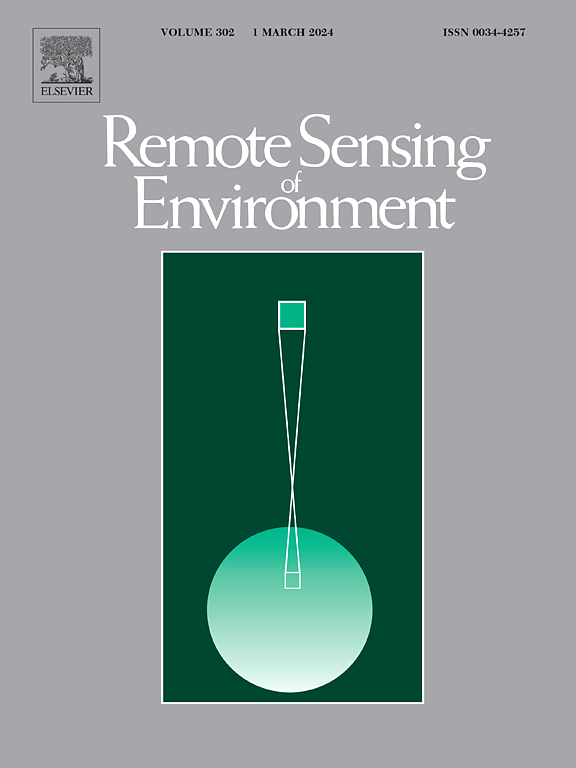A knowledge-augmented deep fusion method for estimating near-surface air temperature
IF 11.4
1区 地球科学
Q1 ENVIRONMENTAL SCIENCES
引用次数: 0
Abstract
Near-surface air temperature (Ta) is a critical meteorological variable, and obtaining its precise spatiotemporal distribution is essential for numerous scientific domains beyond meteorology and hydrology. Despite the promising advancements in Ta mapping using machine learning, these models often suffer from inadequate generalization capabilities due to their heavy reliance on data. A critical limitation is that their “free” learning style fails to deeply uncover the intricate spatiotemporal patterns of Ta. Addressing this problem, we propose a novel knowledge-augmented deep fusion method (KADF), designed to enhance the accuracy of Ta mapping through integrating prior knowledge. KADF integrates three categories of prior knowledge concerning Ta: spatial autocorrelation, temporal autocorrelation, and temporal heterogeneity in the relationship between Ta and predictive variables. This tailored strategy enables the model to more efficiently explore the intricate spatiotemporal relationships between grounded Ta observations and satellite-derived auxiliary variables, culminating in accurate Ta estimates through the deep fusion of these datasets. The efficacy of KADF was thoroughly evaluated over Chinese mainland. The validation results show that KADF accurately mapped the spatiotemporal distribution of daily Ta, with root mean square error (RMSE) values of 1.0 °C for mean Ta (Tmean), 1.22 °C for maximum Ta (Tmax), and 1.33 °C for minimum Ta (Tmin). Moreover, the integration of prior knowledge regarding Ta significantly enhanced the generalizability of the data-driven mapping model. Compared to the state-of-the-art machine learning-based estimation method, KADF reduced the mean absolute error (MAE) values by 23–31 % and RMSEs by 24–29 %. Furthermore, this method considerably improved the ability to capture spatial and temporal variations in Ta across various environmental conditions. Finally, a 1 km daily Ta dataset for the time frame spanning from 2010 to 2018 was produced. Overall, KADF holds great promise for accurately estimating Ta and can be easily adapted to other regions. The source code of KADF has been made publicly available at https://github.com/Henu-frch/KADF.
一种基于知识增强深度融合的近地表空气温度估算方法
近地表气温(Ta)是一个重要的气象变量,其精确的时空分布对于气象学和水文学以外的许多科学领域都至关重要。尽管使用机器学习的Ta映射有了很大的进步,但由于这些模型严重依赖数据,它们的泛化能力往往不足。一个关键的限制是,他们“自由”的学习方式无法深入揭示Ta复杂的时空模式。针对这一问题,我们提出了一种新的知识增强深度融合方法(knowledge augmented deep fusion, KADF),旨在通过整合先验知识来提高Ta映射的精度。KADF集成了关于Ta的三类先验知识:空间自相关、时间自相关和Ta与预测变量之间关系的时间异质性。这种量身定制的策略使模型能够更有效地探索地面Ta观测和卫星衍生辅助变量之间复杂的时空关系,最终通过这些数据集的深度融合获得准确的Ta估计。在中国大陆对KADF的疗效进行了全面评估。验证结果表明,KADF能较准确地反映日Ta的时空分布,平均Ta (Tmean)、最大Ta (Tmax)和最小Ta (Tmin)的均方根误差(RMSE)分别为1.0°C、1.22°C和1.33°C。此外,先验知识的集成显著增强了数据驱动映射模型的泛化能力。与最先进的基于机器学习的估计方法相比,KADF将平均绝对误差(MAE)值降低了23 - 31%,rmse降低了24 - 29%。此外,该方法大大提高了捕获不同环境条件下Ta的时空变化的能力。最后,生成了2010年至2018年期间每日1公里的Ta数据集。总的来说,KADF很有希望准确地估计Ta,并且可以很容易地适应其他地区。KADF的源代码已在https://github.com/Henu-frch/KADF上公开提供。
本文章由计算机程序翻译,如有差异,请以英文原文为准。
求助全文
约1分钟内获得全文
求助全文
来源期刊

Remote Sensing of Environment
环境科学-成像科学与照相技术
CiteScore
25.10
自引率
8.90%
发文量
455
审稿时长
53 days
期刊介绍:
Remote Sensing of Environment (RSE) serves the Earth observation community by disseminating results on the theory, science, applications, and technology that contribute to advancing the field of remote sensing. With a thoroughly interdisciplinary approach, RSE encompasses terrestrial, oceanic, and atmospheric sensing.
The journal emphasizes biophysical and quantitative approaches to remote sensing at local to global scales, covering a diverse range of applications and techniques.
RSE serves as a vital platform for the exchange of knowledge and advancements in the dynamic field of remote sensing.
 求助内容:
求助内容: 应助结果提醒方式:
应助结果提醒方式:


